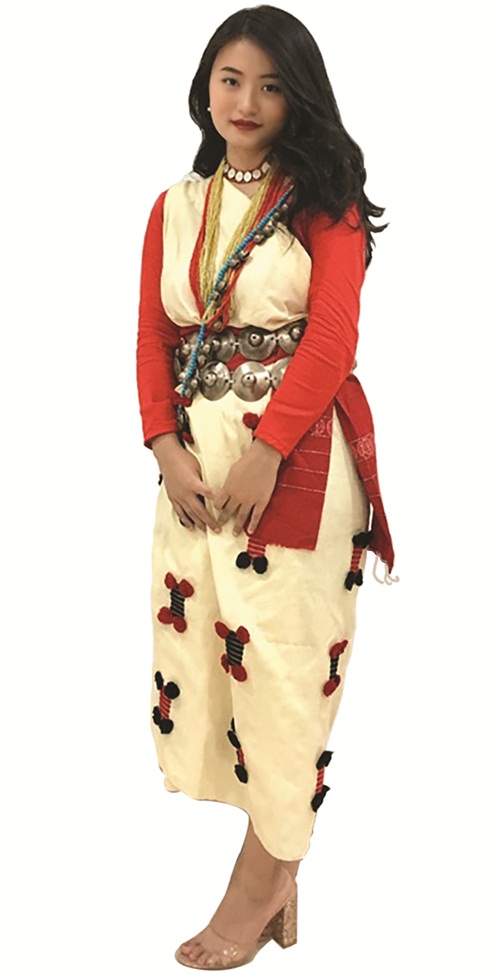We were never taught to speak our tribal language in our homes since childhood. Now Hindi is the lingua franca in the state. Many of the tribal languages can revive only if we learn it and make effort to learn more about our roots.
BENO PANGYA
Arunachal Pradesh is inhabited by various ethnic groups and tribes. Each one of them has a distinct culture, tradition, faith, belief and a social pattern. It was then referred to as a ‘hidden land’; and now as ‘The land of the rising sun’. The state was earlier known as the NEFA (North East Frontier Agency), and it was renamed as Arunachal Pradesh on 20 January 1972.
Out of the many tribes, the Nyishi is the largest tribe in Arunachal Pradesh. Genealogically the Nyishi is a descendant of the great ancestor Aabhu Thanyi. I would like to tell you about my culture and my tribe, Nyishi. Our celebrations are an amalgamation of family beliefs and cultural traditions. My parents raised me with a number of beliefs that have had an impact on who I am today.
Nyokum our festival
Our biggest festival is Nyokum. The term ‘Nyokum’ is composed of two words: ‘Nyok’ that means land and ‘Kum’ means togetherness. This could be the reason why celebrating this festival is considered no less than inviting all the Gods and Goddesses of the Universe. Nyokum is celebrated every year from 26–28 February. On these days, Nyishi men and women gather at an open ground with their traditional attires, forming a big circle and holding hands. They will sing the song ‘Nyokum Bo Tapa Debe’, while moving around in circles and performing traditional dances.

Our Attire
The traditional attire of Nyishi women is a full or half-sleeve red blouse, and a top with a cream-coloured plain cloth, which is tucked tightly over the breast and envelops the body from the armpits to the centre of the calves, on top of the red blouse. A red cloth is then tied at the waist like a ribbon. A girdle consisting of round metals and cane is worn around the waist on top of the red cloth.
Without heavy ornaments our traditional attire is never complete. The ornaments comprise multicoloured beads, which are called ‘tashang’ that symbolises superiority of an individual in the society. Silver or bronze coins fixed with red beads are also worn as a choker on the neck, with heavy earrings and bracelets made out of various metals.
Men’s attire consists of either a plain cream cloth or black and white stripe cloth that is worn the same way a woman wears the red cloth by the waist. Heavier tashang with thick beads are worn on their neck as accessories.
They carry a sword as well known as ‘aryok’ covered in a bamboo sheath. The men wear a hat made out of dried bamboos and finished with a hornbill’s beak and feathers.
The great Indian hornbill
Meanwhile, the great Indian hornbill is the state bird of Arunachal Pradesh. In recent years, it has been found that this bird is on the verge of extinction. The hornbills are now under preservation in sanctuaries. During traditional rites and rituals including weddings, however, Nyishi men still wear the hornbill hat.
Mithun
One of the main integral parts of Nyokum is animal sacrifice. Usually, a mithun is tethered to a structure called ‘yugang’ made up of bamboo. Mithun is akin to gold because it commands the highest value in the barter system. For that matter, this bovine—believed to be a symbol of peace and communal harmony—is sacrificed in many other religious ceremonies including wedding. At wedding it is compulsory for the groom’s family to offer it to the bride. There has been a decrease in the number of animal sacrifice these days, but mithun still is sacred to the Nyishis and many other communities of the state just as how the cow is to many in mainland India.
Abandoned native tongue
In Arunachal Pradesh, each tribe including Nyishi, Adi, Apatani, Galo and others have their own languages but these are mainly used only in villages or amongst elderlies. To many people’s surprise, Hindi is the lingua franca in the state. We were never taught to speak our tribal language in our homes since childhood. Many of the tribal languages can revive only if we learn it and make effort to learn more about our roots. Personally I have had difficulties in communicating with the elderlies who can give us so much knowledge about our culture. I believe our language is a part of our culture and our identity.
These are beliefs that come straight to me from the values of my family. Cultural practices are a way of celebrating life. It constitutes norms and traditions which are exclusive to different regions and religions. Fortunately, the existence of these vibrant cultures is what makes the country rich and diverse.∎
Beno Pangya is from Itanagar, she loves to go back to her roots to understand and to preserve it.